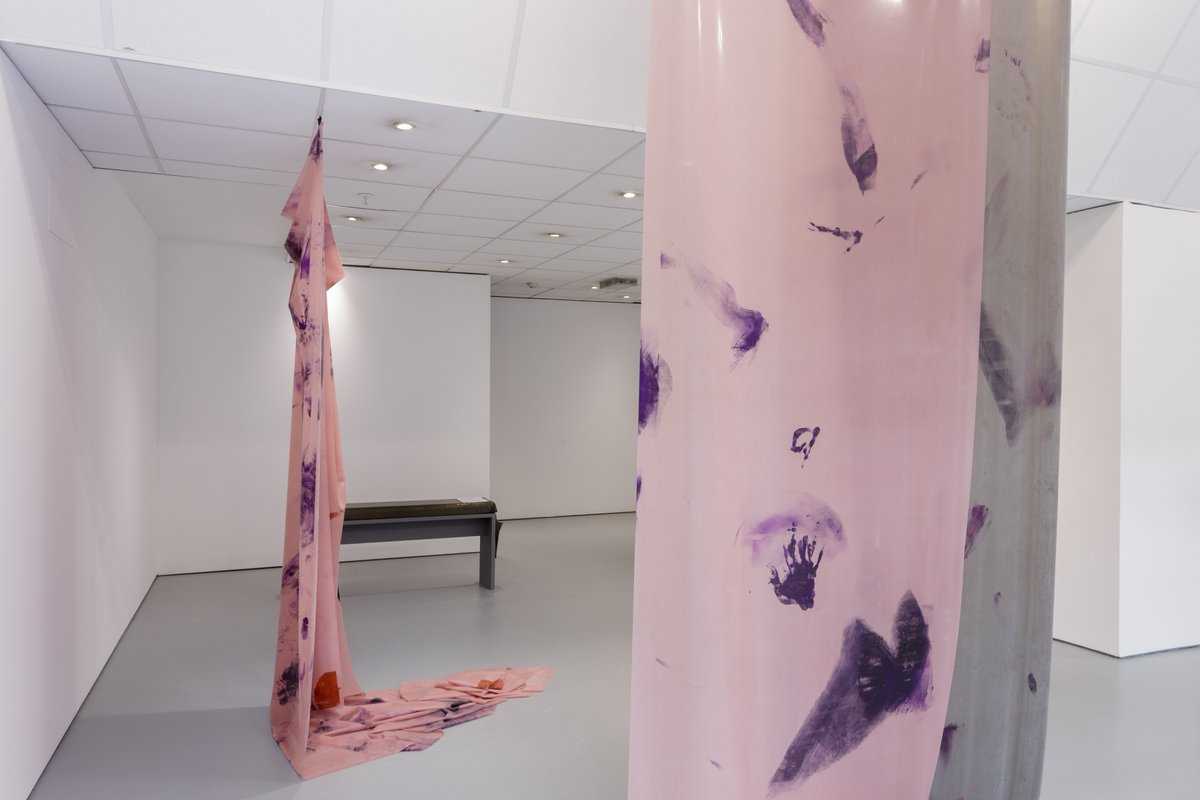Bryony Gillard (DAI, 2015): A cap, like water, transparent, fluid yet with definite body @ Turf Projects till April 29. Red Sophie Risner's review HERE.
" My first interaction with Bryony Gillard’s solo show came from a deep fascination with seats. Those used in the space are wrapped in a latex which, when sat on, billows smoothly beneath, disrupting any slight piece of paper or possession placed next to you into a chaos. It is whilst sat on these comfortable latex seats that you’re drawn into the smooth, plastic and yielding atmosphere entreating the viewer to feel passively attached, subsumed into the ecology of the work.
The first of two rooms works as an altar point to the interwoven negotiation and research being undertaken by Gillard. The focus of ‘Untitled’ (2018) stylistically mirrors the latex-bound pews but this time constriction doesn’t come from being pulled taut but hung suspended. Though wildly different, both approaches to the fabric suggest a complex fascination – a subliminal requirement to touch and investigate the cloth. Prints of body parts further suggest the emotional passage of reflection and resistance forming a frenetic response to an unknown encounter.
Calling you with rhythmic drums, panting and narration, the final room goes further to uncover the genesis of Gillard’s conflict. Encountering ‘A cap, like water, transparent, fluid yet with definite body’ (2018) – an impressively choreographed and directed film – the viewer may well attempt to straddle one of the faux-bean bags on the floor, only to find them filled with air which fast dissipates and leaves you lying prone. Here, Gillard works to ensure that all spaces classically reserved for contemplation become uncomfortable moments of physical unease.
‘Rationalism is a tyranny’ was the first statement I digested upon entering the space. Bodies slip and slide, holding each other then removing themselves with red faces, constriction, surrender and possible elation. The film possesses a myriad of interwoven narratives – embracing in a complex symbiosis. No move is made in this film to make reason any more accessible. The theory it wrestles with builds on what the Modernist poet H.D recalls as her ‘jellyfish experience’ to her lesbian lover Bryher during their retreat to the Isles of Scilly in 1919. Here, footage of jellyfish comes into focus as the camera jars and darts between the tentacles. H.D appropriates the hidden strength of these poisonous, drifting, amorphous creatures, unfurling this conflicted organism as a metaphor for female erotic connectivity, creative autonomy and resistance. H.D locates a place where experience lives and can be felt but might not be describable or comparable to current cultural norms – as a way to reconnect with physical and mental belonging that predates the aggressive requirement for societal definition
Gillard furthers this by re-appropriating H.D’s ideology – within the film human bodies retreat back to the form of a jellyfish, reassembling their physicality to drill deeper into the possibilities and emancipatory potential first felt by H.D back in Scilly. The scope of this approach builds a new design of human connectivity that fluidly adapts to change, its tentacles taking up space, shifting and expanding. This new format finds a reckoning with exploration that no longer subscribes to rigid terminology, questioning whether – in order to transform the tools we have designed to guide our humanity – we must first locate resistance by surrendering what makes us human."
Sophie Risner
Published on 17 April 2018 in
Contemporary Art Magazine


